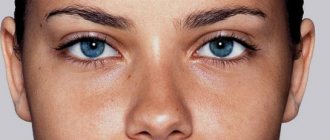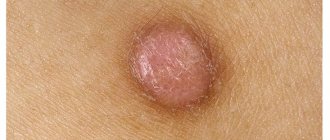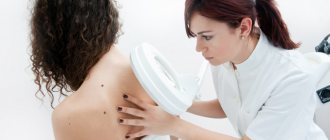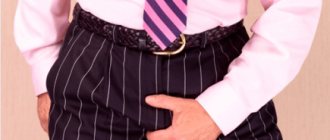Weeping dermatitis is one of the types of skin diseases that develops under the influence of negative external or internal factors on the epidermal tissue. In most cases, weeping of the skin occurs after pathogens of streptococcal infection enter the dermis. Weeping dermatitis is distinguished by the fact that the surface of the affected skin is in a constant state of inflammation, wet to the touch, and over time becomes covered with ulcerative formations with the release of purulent contents. Based on its location, this disease can occur on any part of the body, but most often occurs in folds and places where the skin is poorly ventilated.
What is weeping
Weeping is a weeping area on the skin that occurs as a result of an abnormal process, which is expressed in the exudation (secretion) of serous, bloody or purulent fluid (exudate) through small erosions (damages) of the epidermis (the upper layer of the skin).
Weeping is not a disease, it is a sign of a pathological process occurring in a separate area of the skin or a symptom of internal disorders and dermatological diseases.
Serous exudate looks like a transparent whitish liquid containing proteins, leukocytes (white blood cells), breakdown products, and toxins.
The leading factors in the manifestation of weeping erosions due to exudation are considered to be:
- increased permeability of blood vessels (capillaries, venules - small veins) as a result of inflammation or aggression of allergens;
- as well as an increase in pressure in the vessels of affected tissues due to hyperemia (overflow of blood).
Weeping behind the ears of a child (photo)
What is it and what are the causes of weeping dermatitis?
The main factors for the painful condition of the skin with the development of weeping dermatitis are associated with bacterial infection or dysfunction of the digestive system. There are cases when this dermatological disease develops due to the presence of other pathogenic factors. The following are the causes of weeping dermatitis in men and women.
Skin intoxication
People working at chemical industry enterprises who have daily contact with liquid chemicals or their vapors are faced with the fact that the surface layer of the epithelium is saturated with toxic substances and is gradually destroyed. This process of chemical damage to the skin begins with the manifestation of weeping dermatitis, and ends with the formation of trophic ulcers of various diameters and depth of destruction of epidermal tissues. People living in areas with unfavorable environmental conditions are also at risk.
Digestive system diseases
In the process of processing and assimilation of consumed food, a large number of organs of the digestive system are involved. If the pancreas, intestines, liver or gall bladder do not fully cope with their functions aimed at breaking down food, then the skin begins to be the first to respond to problems in this part of the body. Local irritations appear, which soon acquire all the signs of weeping dermatitis. The more serious the disease of one or several organs of the digestive system, the more pronounced the symptoms of weeping dermatitis. Without eliminating the main causative factor in the development of weeping, it is impossible to completely cure the skin from the manifestation of this type of dermatitis.
Infectious infection
weeping dermatitis in the photo
Weeping dermatitis can still develop under the influence of the pathogenic activity of pathogenic microflora. This factor is a streptococcal infection, which penetrates into a previously damaged area of the skin and begins to build its colonies, destroying the surface layer of the epithelium. As a result, the red, inflamed and constantly weeping area of the skin gradually transforms into an ulcer, on the surface of which a chronic process of increasing the population of bacteria takes place.
The product of streptococcal infection is purulent contents, which are released in excess quantities from the wound neoplasm. If the cause of weeping dermatitis lies precisely in the infectious nature of its origin, then the purulent fluid secreted from the wound constantly forms a dense crust, the wound heals a little, and then increases in size again.
Complicated form of allergy
Patients prone to allergic reactions that affect the painful condition of the skin are faced with complicated forms of urticaria. This happens if a person has suffered for a long time from an allergy to one or another potential irritant of the epithelium, the skin was in a constant state of stress, and there was no proper drug treatment. Such areas of the skin begin to change their cellular structure and weeping dermatitis develops.
This condition of epidermal tissues, which has developed due to a complicated form of allergy, is dangerous because in the event of ulcers, the site of chronic weeping is very difficult to cure and restore the full functionality of the affected epithelium.
Fungus
Invasion of a fungal infection into the skin surface is one of the most common reasons why weeping dermatitis begins to develop. Infection with fungal spores can occur in public places, during visits to baths, saunas, swimming pools, and public showers.
A distinctive feature of the fungal cause of the development of weeping is that the fungus provokes not only redness of the skin, but also causes an unpleasant yeasty odor. Most often, areas of the skin that are located in folds and areas with poor air ventilation begin to get wet. The fungal type of weeping dermatitis is also called dermatomycosis. Most often it occurs in adults and children living in old wooden houses whose walls are affected by mold fungi.
Hormonal imbalance
An excess or deficiency in the body of hormones that take part in metabolic processes occurring at the cellular level of the epithelium leads to the development of weeping dermatitis with the formation of multiple foci of irritation of the skin. In most cases, this pathology is encountered by people who have diseases of the endocrine system, endocrine glands, use oral contraceptives based on synthetic hormones, or regularly take anabolic steroids for more accelerated division of epithelial cells and muscle tissue growth.
Medications
Some types of medications for external use have side properties, expressed in atrophy of the skin at the sites of their use. These negative consequences most often result from prolonged use of corticosteroid ointments. At the first stage of the manifestation of such effects of this type, a stable weeping of the skin develops, and then the epithelial layer becomes thin and transforms into an ulcerative surface.
Human skin is a voluminous external organ of the body, which is distinguished by its complex structure. Therefore, the presence of other causative factors that can provoke the development of weeping dermatitis on the epithelial surface, which recently had a completely healthy appearance, cannot be ruled out.
How to identify it in yourself
It is quite easy to identify your own weeping. In the area of skin damage, against a background of inflammation, swelling, and redness, multiple pinpoint lesions (erosions) covered with moisture are visible. The skin looks wet and shiny.
This phenomenon is observed in the following conditions:
- inflammation (viral, bacterial, fungal nature);
- opening of vesicles (vesicles, blisters);
- intense scratching;
- superficial and deep wounds, ulcers;
- burns, frostbite.
What disorders may this symptom indicate?
In the vast majority of cases, weeping as a symptom is characteristic of the following diseases:
- atopic, weeping dermatitis, all types of itchy dermatitis;
- exudative psoriasis;
- versicolor - eczema;
- blistering dermatoses, including pemphigus, bullous pemphigoid, epidermolysis;
- contagious (wetting) impetigo;
- bedsores and diaper rash;
- trophic ulcers;
- serous or purulent omphalitis (“weeping navel”) in infants - a pathology with characteristic exudate from the umbilical wound and slow healing;
- weeping hemorrhoids (III – IV stage of the disease);
- burns and frostbite;
- chicken pox;
- purulent skin lesions, including: diffuse and ulcerative streptoderma (ecthyma), intertriginous streptoderma (streptococcal intertrigo).
Treatment methods for weeping dermatitis
Due to the fact that weeping dermatoses occur due to systemic imbalance of the body, treatment should be comprehensive:
- drug therapy;
- change in eating habits (change of diet);
- Some patients also use the experience of traditional medicine.
Whether to use folk remedies or not is up to everyone to decide for themselves. But it would still be wiser to consult a doctor.
Changing your diet
Often there is a need to radically change your menu and give up foods that can trigger allergies:
honey;- pineapples;
- citrus;
- chocolate;
- eggs;
- tomatoes;
- kiwi;
- strawberry;
- confectionery;
- fatty, fried and smoked foods.
Allowed to eat:
- vegetables (broths, stews);
- cereals (buckwheat, millet, oatmeal);
- lean meats and fish (boiled or steamed);
- fermented milk products: kefir, fermented baked milk, cottage cheese;
- plenty of liquid (ideally clean water).
Eating plant foods will be more beneficial (especially during the acute period of the disease). The only fats allowed are olive and flaxseed oil. And there should be a sufficient amount of greens in the diet.
How to deal with this symptom
Since weeping is a symptom phenomenon, complete relief from it is possible by curing the causative disease in which this symptom occurs. Thus, with weeping eczema, therapy aimed at eliminating neurotic disorders and neuroendocrine disorders will also affect the external signs of the disease, including weeping.
Local preparations that are used externally can significantly reduce the severity of this unpleasant manifestation, reduce tissue inflammation and the intensity of exudate, dry the wound area, relieve itching and burning.
Important! The use of any drug requires mandatory review of the instructions and agreement with the doctor, since the choice of a specific gel, emulsion, solution depends on the type of disease. A medicine recommended for weeping caused by one pathology may be prohibited for another disease.
General recommendations
Weeping or vesicles (bubbles) with exudate usually indicate the acute stage of the disease, when the skin is easily infected, primarily by staphylococci and streptococcal flora.
Many experts insist that at the stage of fluid secretion, one should not use anti-inflammatory fatty ointments, which can worsen the condition of the affected areas, but only creams and emulsions that do not interfere with the evaporation of moisture.
In case of severe exudation against the background of various skin lesions, zinc-based drying and astringent agents, creams and emulsions, lotions and wet-dry dressings with medicinal solutions, non-steroidal and serious hormonal ointments with anti-exudative action are used.
This video will tell you how to treat and how to treat weeping with atopic dermatitis:
Lotions
One of the simple and effective ways to soften weeping acute inflammatory processes (dermatitis, eczema) is cold lotions and wet-drying with medicinal solutions. The mechanism of action is based on the evaporation of water, cooling the skin, astringent and drying effect. When the skin cools, the blood vessels in the affected weeping area constrict, which leads to a decrease in the severity of weeping and inflammation.
For lotions use:
- Burov's liquid (1 teaspoon per 200 ml of water);
- boric acid 2%;
- silver nitrate 0.025%;
- tannin solution 4%;
- Dimexide solution (including erysipelas, eczema, deep burns) 25 – 90%;
- Resorcinol 1%.
Experts often advise that in case of “wet” skin changes, make lotions not with alcohol, so as not to dry out or burn the damaged skin, but with water or saline solution. The most gentle effects have:
- furatsilin (1 tablet per 200 ml of water);
- solution of potassium permanganate (potassium permanganate 0.05%) pale pink;
- decoctions with oak bark, black currant leaves, tricolor violet, chamomile, birch buds, sage, bay leaf, coltsfoot herb;
- weak brew of black tea;
- mumiyo solution (3 grams per glass of water).
It is advisable to keep the lotion solution in the refrigerator. A wide bandage folded in several layers is moistened in it, wrung out very well, and applied to the affected area. As soon as the lotion begins to warm up (after 5 minutes), the procedure is repeated with a cool solution. Duration – up to one and a half hours, twice a day.
For the bandage, use up to 12 layers of gauze, put a little absorbent cotton wool (natural) on top, secure it loosely with a bandage and change it after 1 to 3 hours as it dries. Bandages act similar to lotions, but are less effective.
Important! Do not allow the lotions to become warm, as this may increase exudation and inflammation.
Separately, it should be said about weeping hemorrhoids. To reduce weeping in the anal area, lotions and baths with knotweed, chamomile, burdock root, oak bark, eucalyptus, and rowan are used. Add mumiyo, garlic juice, onion peel decoction, propolis, birch tar and sea buckthorn oil.
Wetting of the skin on the back of the hands
Drugs for inflammatory processes with exudation
In the combined treatment of weeping areas, in addition to lotions, external agents of varying degrees of effectiveness are used.
External medications that help with weeping:
| A drug | Pathologies |
| Desitin cream |
Especially recommended for young patients due to the minimum of side effects |
| Tsindol, chatterbox | |
| Zinc paste | |
| "Ambulance". Natural powder | Drying agent for various injuries with weeping. Anti-inflammatory, disinfectant, healing effect |
| Baneocin powder |
|
| Powder and powder Xeroform |
Low toxicity, non-irritating, minimal adverse reactions |
| Fukortsin | Use with caution to avoid drying and burning the skin. Possible severe burning sensation. |
| Methylene blue | |
| Brilliant green (“zelenka”) | |
| Elidel (stronger analogue - Protopic) | Atopic dermatitis, weeping eczema (except microbial) |
| Elokom cream, lotion; Momat cream |
Use caution in children and large affected areas |
| Hormonal agents | |
| Sinaflan liniment (highly active glucocorticosteroid) | “Wet” dermatitis, eczema, diaper rash and bedsores with exudate, exudative forms of erythema, psoriasis |
| Advantan, emulsion (highly active) | Used for acute and chronic dermatitis, eczema accompanied by exudation. Suppresses inflammatory reactions associated with increased exudation, leading to a reduction in weeping, itching, pain, and irritation |
| Afloderm cream (moderate activity) | In particularly sensitive areas (face, chest, genitals). Allowed for children from 6 months, nursing and pregnant women |
| Flucinar gel (highly active) | For “wet” eczema and dermatitis with weeping |
| Lokoid Crelo, emulsion (low-active), Lokoid cream | Weeping areas in various skin pathologies |
Active non-hormonal agents for severe erosion
For weeping lesions on the skin, it should be borne in mind that symptom treatment is carried out in stages, taking into account the stages of the pathological process in these areas. First, dry it, then protect it.
Strong non-steroidal drugs:
- Stellanin PEG ointment.
Stellanin PEG with antimicrobial, regenerating and anti-inflammatory effects, unlike Stellanin ointment, is used specifically for weeping skin pathologies associated with infection:- trophic weeping ulcers, bedsores;
- weeping areas due to burns;
- severe scratching after insect bites.
- Gel Solcoseryl.
It is the medicinal form of Solcoseryl in the form of a fat-free gel that reduces and prevents exudation and wetting of wound areas, and stimulates the formation of collagen fibers.
If the exudate ceases to be released and the process of “drying” occurs, you can begin to use ointments Solcoseryl, Stellanin, Actovegin, which create a protective film.
The meaning of the word wetting
Examples of the use of the word wetting in literature.
Eruptions on the scalp, crusty, eczematous, oozing, sticky, vesicular, scaly.
In acute inflammatory processes accompanied by weeping, the use of powder is contraindicated due to the formation of crusts, under which inflammatory processes intensify.
With complete fistulas, after the remnant of the umbilical cord falls off, the umbilical wound becomes weeping; through the wide lumen formed at the junction of the intestine with the navel area, intestinal contents are released and the bright red intestinal mucosa is visible.
With incomplete fistulas, there is a prolonged weeping of the umbilical wound, less often - irritation of the skin around the navel, and in case of infection - purulent discharge from the navel.
Milky scab on the scalp and ears, with oozing, thick yellow crusts raised above the skin, with severe itching, which is worse in the warmth of the bed.
Mucous discharge from the anus and constant weeping in the external parts.
The patient cannot stop until he tears off his skin, after which weeping, bleeding, pain and inflammation occur.
Swelling and redness of the skin of the ear canal, peeling, weeping, mucous or purulent discharge.
Subsequently, bubbles, cracks, desquamation, and weeping appear in various areas, and the newborn’s body looks like it has been burned with boiling water.
After the weeping stops, dermozolon, mycozolon are used, and then alcohol fungicidal solutions, Castellani paint, and finally, if necessary, fungicidal pastes and ointments.
In addition to weeping and the presence of discharge, there is a protrusion of the navel, redness and swelling of the skin around it, red stripes are visible on the anterior abdominal wall, characteristic of inflammatory damage to the lymphatic vessels, dilated superficial arteries and veins.
Eczematous and herpetic rashes with a oozing sticky consistency are possible on the face.
In cases of an acute process with profuse weeping and swelling, it is first necessary to calm the inflammatory phenomena.
In case of inflammation and weeping of the skin, baths with anti-inflammatory drugs are prescribed as directed by the treating pediatrician.
The rashes are represented by blisters, burning weeping or dry eczematous, herpetic pustules covered with scabs, scaly blisters.
Source: Maxim Moshkov library









